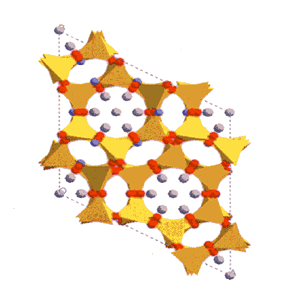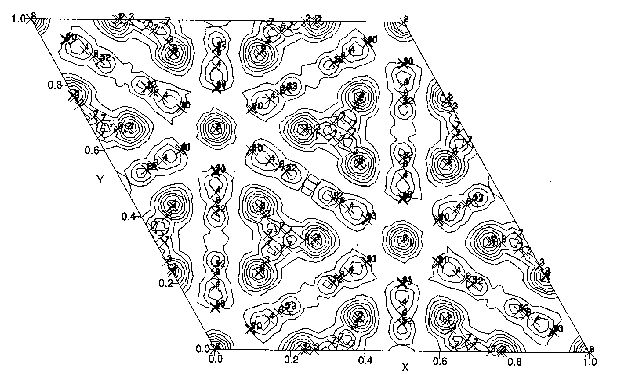Powder
Diffraction: Many materials (often
those of major industrial or pharmaceutical importance including zeolites, polymers,
pharmaceuticals etc.) cannot be crystallized and exist only as powders.
In powder diffraction a three-dimensional diffraction pattern is collapsed onto
one-dimension by spherical averaging, and as a result, reflections, which would
otherwise be separately measured, overlap. The degree of overlap increases
with Bragg angle and unit cell dimensions, thus often reducing the effective resolution
of the data set to 1.5Å or less - in may cases this is closer to 2Å.
In general, overlaps arise from the accidental coincidence of Bragg angle, but
they can also arise systematically as a consequence of space group symmetry. Synchrotron
radiation with its high intensity, and a highly collimated incident beam can also
be of great assistance in resolving overlaps experimentally, but many samples
exhibit an intrinsic line broadening or non accidental overlaps can be present,
so there is a need for a systematic approach to this problem that is capable of
utilising overlap information in an active way. The
use of the ME formalism has been extended to the powder case. In particular, the
overlaps are used in the normalisation procedure, and the use of likelihood to
test phase hypotheses is extended to use both overlapped and non-overlapped reflections.
In addition, the latter can be included in the basis set as constraints for entropy
maximisation using the concept of hyperoctant phase permutation, and the
overlaps are also used in the final centroid maps, so they play an active, and
essential role in the entire phasing procedure.
The structure of the NU-3 zeolite (left) and the electron density maps from
the maximum entropy method (right)
Research
funded by Eastman-Kodak.
References for Powder
Diffraction
- 'The maximum entropy method of solving crystal structures from electron diffraction data.' C.J. Gilmore in Electron Crystallography: Novel approaches for structure determination of nanosized materials. Weirich, Labar & Zou (eds) Chapter C6, (2005).
- 'Electron crystallography of Zeolites - the MWW Family as a Test of Direct 3-D Structure Determination' D.L. Dorset, W.J. Roth & C.J. Gilmore. Acta Cryst. (2005). A38. 516-527.
- 'Comparison of Electron Diffraction data from Non-linear Optically Active Organic DMABC Crystals Obtained at 100kV and 300kV' I.G.Voigt-Martin, H.Kothe, A.V.Tenkovtsev, H.Zandbergen, J.Jansen and C.J.Gilmore Ultramicroscopy (2000), 83, 33-59.
- 'The maximum entropy approach'
C.J.Gilmore, K.Shankland & W. Dong, (2001), In press.
- 'The Ab Initio
Solution of Structures from Powder Diffraction Data: the use of Maximum Entropy
and Likelihood to Determine the Relative Amplitudes of Overlapped Reflections
Using the Pseudophase Concept' W.Dong & C.J.Gilmore. Acta Cryst.
(1998), A54, 438-446.
- 'Ab initio Determination
of Molecular Crystal Structures Using Powder Diffraction Data from a Laboratory
X-ray Source', P.Lightfoot, M.J.Tremayne, K.D.M.Harris, C.Gildewell, K.Shankland
C.J. Gilmore, & P.G.Bruce. (1993), Material Science Forum, 133-136,
207-212.
- 'The ab initio
Determination of Crystal Structures from their Powder Diffraction Patterns
Using a Combination of Entropy Maximisation and Likelihood Ranking', K.Shankland
& C.J. Gilmore, (1993), Material Science Forum, 133-136, 189-194.
- 'Ab initio Structure
Determination of LiCF3SO3 from X-ray Powder
Diffraction Using Entropy Maximisation and Likelihood Ranking', M.Tremayne,
P.Lightfoot, M.A.Mehta, P.G.Bruce, K.D.M.Harris, K.Shankland, C.J.Gilmore,
& G.Bricogne, J.Solid State Chem. (1992), 100, 191-196.
- 'Application of the
Combined Maximum Entropy and Likelihood Method to the ab initio Determination
of an Organic Crystal Structure from X-ray Powder Diffraction Data', M.Tremayne,
P.Lightfoot, C.Glidewell, K.D.M.Harris, K.Shankland, C.J.Gilmore, G.Bricogne
& P.G.Bruce, J.Mater. Chem. (1992), 2, 1301-1302.
- 'A Multisolution Method
of Phase Determination by Combined Maximisation of Entropy and Likelihood.
IV The Ab-initio Solution of Crystal Structures from X-ray Powder Diffraction',
C.J. Gilmore, K.Henderson & G.Bricogne, Acta Cryst. (1991), A47,
830-841.
- 'The Challenge of X-ray
and Neutron Powder Diffraction', C.J.Gilmore & K.Henderson in Bayesian
Methods and Maximum Entropy Ed. J.Skilling, Kluwer, (1989), 233-239.



